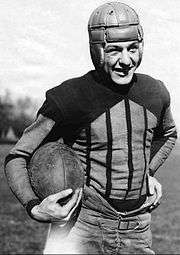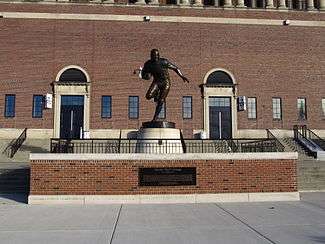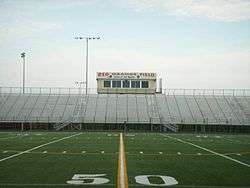Red Grange
 | |||||||
| No. 77 | |||||||
|---|---|---|---|---|---|---|---|
| Position: | Halfback | ||||||
| Personal information | |||||||
| Date of birth: | June 13, 1903 | ||||||
| Place of birth: | Forksville, Pennsylvania | ||||||
| Date of death: | January 28, 1991 (aged 87) | ||||||
| Place of death: | Lake Wales, Florida[1] | ||||||
| Height: | 5 ft 11 in (1.80 m) | ||||||
| Weight: | 175 lb (79 kg) | ||||||
| Career information | |||||||
| High school: | Wheaton (IL) | ||||||
| College: | Illinois | ||||||
| Career history | |||||||
| Career highlights and awards | |||||||
| |||||||
| Career NFL statistics | |||||||
| |||||||
Harold Edward "Red" Grange (June 13, 1903 – January 28, 1991), nicknamed "The Galloping Ghost", was an American football halfback for the University of Illinois, the Chicago Bears, and for the short-lived New York Yankees. His signing with the Bears helped legitimize the National Football League (NFL).[2] He was a charter member of both the College and Pro Football Halls of Fame.
In college, Grange was a three-time consensus All-American, leading his team to a national championship in 1923. He was the only consensus All-American running back in 1924 who was not a member of the Four Horsemen. The same year, Grange became the first recipient of the Chicago Tribune Silver Football award denoting the Big Ten's most valuable player.[3] In 2008, he was named the best college football player of all time by ESPN, and in 2011, he was named the Greatest Big Ten Icon by the Big Ten Network.
Early life
"Red" Grange was born on June 13, 1903, in Forksville, Pennsylvania, a village of about 200 people in an area of lumber camps.[4] His father was the foreman of three lumber camps.[4] His mother died when he was just five years old.[5] For a number of years, the Grange family lived with relatives until they could finally afford a home of their own in Wheaton, Illinois.
When they arrived in Wheaton, Grange’s father worked hard and became the chief of police.[6] At Wheaton High School,[note 1] Grange earned 16 varsity letters in four sports (football, baseball, basketball, and track)[6] during the four years he attended, notably scoring 75 touchdowns and 532 points for the football team.[6] As a high school junior, Grange scored 36 touchdowns and led Wheaton High School to an undefeated season. In his senior year, his team won every game but one in which they lost 39–0 to Scott High School in Toledo, Ohio.[4] Knocked out in this game, Grange remained unconscious for two days, having difficulty speaking when he awoke.[4] In addition to his success in football, Grange was an all-state track and field runner. In 1920, Grange was a state champion in the high jump, while placing third and fourth in the 100-yard dash and the 220-yard dash, respectively. In 1921, he won the state title in both the long jump and the 100-yard dash, and finally in 1922, he placed third in the 100-yard dash and won the 220-yard dash.[7]
To help the family earn money, he took a part-time job as an ice toter for $37.50 per week,[6] a job which helped him to build his core strength (and provided the source of one of his nicknames: "Ice Man", or "the Wheaton Ice Man").[8]
University of Illinois
After graduation, Grange enrolled at the University of Illinois, where he was admitted to the Zeta Psi fraternity.[6] He had initially planned to compete in only basketball and track, but changed his mind once he arrived and joined coach Bob Zuppke's Fighting Illini football team.
College football
Grange played for the team from 1923 to 1925. In his first collegiate football game, he scored three touchdowns against Nebraska.[6] He once scored four touchdowns in twelve minutes.[9] In seven games as a sophomore, he ran for 723 yards and scored 12 touchdowns, leading Illinois to an undefeated season and the Helms Athletic Foundation national championship.[10]

Grange vaulted to national prominence as a result of his performance in the October 18, 1924 game against Michigan, in the grand opening game of the new Memorial Stadium, built as a memorial to Illini students and alumni who had served in World War I.[6] The Michigan Wolverines entered the game as favorites, having also won a national title in 1923, and were going for another this year.
Grange returned the opening kickoff for a 95-yard touchdown and scored three more touchdowns on runs of 67, 56, and 44 yards in the first 12 minutes–the last three in less than seven minutes.[10] On his next carry, he ran 56 yards for yet another touchdown. Before the game was over, Grange ran back another kickoff for yet another touchdown. He scored six touchdowns in all. Illinois won the game by a lopsided score of 39 to 14. Michigan coach Fielding Yost said "All Grange can do is run." To which the Illinois coach, Bob Zuppke, referring to a famed opera star of the age, responded, "And all Galli-Curci can do is sing."[11]
The game inspired Grantland Rice to write this poetic description:
A streak of fire, a breath of flame
Eluding all who reach and clutch;
A gray ghost thrown into the game
That rival hands may never touch;
A rubber bounding, blasting soul
Whose destination is the goal — Red Grange of Illinois![12]

However, Chicago sportswriter Warren Brown nicknamed Grange "The Galloping Ghost". When questioned in a 1974 interview, "Was it Grantland Rice who dubbed you the Galloping Ghost?", Grange replied, "No, it was Warren Brown, who was a great writer with the Chicago's American in those days."[6]
As a college senior in 1925, in a 24–2 upset of the University of Pennsylvania, Grange rushed for a career-high 237 yards through deep mud and scored three touchdowns. Laurence Stallings, a famed war correspondent who had co-written What Price Glory? was hired to cover the game for the New York World. After Grange accounted for 363 yards, Stallings said, "This story's too big for me. I can't write it."[10] Grange's younger brother Garland followed his footsteps to also play football at Illinois.[13]
In his 20-game college career, Grange ran for 3,362 yards, caught 14 passes for 253 yards, and completed 40 of 82 passes for 575 yards. Of his 31 touchdowns, 16 were from at least 20 yards, with nine from more than 50 yards.[10] He scored at least one touchdown in every game he played but one, a loss to Nebraska in his senior season. He earned All-America recognition three consecutive years, and appeared on the October 5, 1925, cover of Time.[10] His number 77 was retired at the University of Illinois.[note 2]
In 2002, the NCAA published "NCAA Football's Finest," researched and compiled by the NCAA Statistics Service.[15] For Grange they published the following statistics:
College career statistics
| Year | Carries | Rush yards | Average | Pass attempts | Completions | Pass yards | Interceptions | Plays | Total offense | Touchdowns | Points |
|---|---|---|---|---|---|---|---|---|---|---|---|
| 1923 | 129 | 726 | 5.6 | 9 | 4 | 36 | 0 | 138 | 759 | 12 | 72 |
| 1924 | 113 | 743 | 6.6 | 44 | 26 | 433 | 4 | 157 | 1,176 | 13 | 78 |
| 1925 | 146 | 605 | 4.1 | 29 | 10 | 106 | 7 | 175 | 711 | 6 | 36 |
| Total | 388 | 2,071 | 5.3 | 82 | 40 | 575 | 11 | 470 | 2,646 | 31 | 186 |
NFL career

Grange was immediately courted by teams in the National Football League. The long-suffering Rochester Jeffersons made a last-ditch effort to sign Grange at a salary of $5,000 per game, but were unable to do so, a key factor in the team's demise.[16] The Chicago Bears ultimately signed him; player/manager George Halas agreed to a contract for a 19-game barnstorming tour, signed the day after Grange played his last college game. The contract earned Grange a salary and share of gate receipts that amounted to $100,000, during an era when typical league salaries were less than $100/game.[10] That 67-day tour is credited with legitimizing professional football and the NFL in the United States.
On December 6, 1925, between 65,000 and 73,000 people showed up at the Polo Grounds to watch Grange, helping save the New York Giants' franchise.[10][17] Grange scored a touchdown on a 35-yard interception return in the Bears' 19–7 victory. Offensively, he ran for 53 yards on 11 carries, caught a 23-yard pass, and completed two of three passes for 32 yards.[10] In his first year, he accounted for at least 401 total yards and three touchdowns in his five official NFL games for the Bears.
Grange became involved in a dispute with the Bears and left to form his own league, the American Football League, to challenge the NFL.[18] The league only lasted one season, after which Grange's team, the New York Yankees, was assimilated into the NFL. In 1927, Grange suffered a serious knee injury against the Bears, which robbed him of some speed and his cutting ability. After sitting out 1928, Grange returned to the Bears, where he remained as a solid player through 1934.[19]
The two highlights of Grange's later NFL years came in consecutive championship games. In the unofficial 1932 championship, Grange caught the game-winning touchdown pass from Bronko Nagurski. It was argued the pass was illegal.[20] In the 1933 championship, Grange made a touchdown-saving tackle that saved the game and the title for the Bears.[21]
He was a very modest person,[22] who insisted that even the ordinary plumber or electrician knows more about his craft than he does. He said he could not explain how he did what he did on the field of play, and that he just followed his instincts.[23]
Hollywood career
Grange's manager, C. C. Pyle, realized that as the greatest football star of his era, Grange could attract moviegoers, as well as sports fans.[24] During his time as a professional football player, Grange starred in two silent films, One Minute to Play (1926) and Racing Romeo (1927). Grange also starred in a 12-part serial series The Galloping Ghost in 1931.
Later life and legacy
Grange retired from professional football in 1934, earning a living in a variety of jobs including motivational speaker and sports announcer. In the 1950s, he announced Chicago Bears games for CBS television and college football (including the Sugar Bowl) for NBC. Grange married his wife Margaret, nicknamed Muggs, in 1941, and they were together until his death in 1991. She was a flight attendant, and they met on a plane. The couple had no children. He, however, has one surviving daughter – Rosemary Morrissey – born in 1928 from a previous relationship with Helen Flozack.[10]
Grange's autobiography, first published in 1953, is The Red Grange Story. The book was written "as told to" Ira Morton, a syndicated newspaper columnist from Chicago.[25]
Grange developed Parkinson's disease in his last year of life[10] and died on January 28, 1991, in Lake Wales, Florida.
Legacy

To commemorate college football's 100th anniversary in 1969, the Football Writers Association of America chose an all-time All-America team. Grange was the only unanimous choice.[10] Then in 1999, he was ranked number 80 on The Sporting News list of the 100 Greatest Football Players. In 2008, Grange was also ranked #1 on ESPN's Top 25 Players In College Football History list.
In honor of his achievements at the University of Illinois, the school erected a 12-ft statue of Grange at the start of the 2009 football season. In 2011, Grange was announced as number one on the "Big Ten Icons" series presented by the Big Ten Network.
In 1931, Grange visited Abington Senior High School in Abington, Pennsylvania, a suburb of Philadelphia. Shortly thereafter, the school adopted his nickname for the mascot in his honor, the Galloping Ghost.[26] Also, Wheaton Warrenville South High School's football field is named in his honor and the team is referred to as the Wheaton Warrenville South Red Grange Tigers. Annually, the Wheaton Warrenville South Boys Track and Field team hosts the Red Grange Invitational in honor of Grange's achievements in track and field.
On January 15, 1978, at Super Bowl XII, Grange became the first person other than the game referee to toss the coin at a Super Bowl.
In popular culture
- In the song "With Her Head Tucked Underneath Her Arm" as released in 1960 by The Kingston Trio on their album Sold Out, guards in the Tower of London mistake Anne Boleyn, haunting the castle with her head tucked underneath her arm after being beheaded, for Red Grange carrying a football.
- The 2008 movie Leatherheads, starring George Clooney, John Krasinski, and Renée Zellweger, was loosely based on Grange.[27]
- Grange was the first football player to ever appear on a box of Wheaties.[28]
- Al Bundy is mistaken for Red Grange several times in the Married... with Children episode "Poke High" (episode 3, season 3).
- In the play Death of a Salesman by Arthur Miller, the lead character, Willy Loman, says that his football-playing son (Biff) will be the next Red Grange.[29]
- In M*A*S*H, season 3, episode 21 ("Big Mac"), Major Frank Burns is chided for burning The Life of Red Grange.
- In the American Dad! episode "The Magnificent Steven", while trying to teach Steve and his friends to be tough by playing football, Stan finds the boys hiding from the sunlight under a tree and exclaims "What, in the name of Red Grange, is going on?!"
- In the movie The Right Stuff, Chuck Yeager (played by Sam Shepard) says he'll "look like the Gallopin' Ghost" in the leather helmet Ridley gives him to wear on his Bell X-1 test flight.
See also
- List of unanimous college football All-Americans
- List of people on the cover of Time Magazine: 1920s
Notes
- ↑ The site of the original Wheaton Grade School and Wheaton High School housed in the same physical building constructed in 1874 and in operation with classes in 1876 is now known as Longfellow Elementary School.
- ↑ Only one other number has been retired in the history of Illinois football, 50, worn by Dick Butkus, another Bears player.[14]
References
- ↑ "College Football Hall of Fame || Famer Search". collegefootball.org. Retrieved 7 April 2011.
- ↑ "Red Grange, Football Hero of 1920's, Dead at 87". The New York Times. 29 January 1991.
- ↑ Rosenthal, Phil (December 3, 2009). "Chicago Tribune Silver Football, the Big Ten's MVP award, is headed to TV". Tower Ticker. Chicago Tribune
- 1 2 3 4 "About Harold "Red" Grange". Wheaton High. Archived from the original on October 8, 2007. Retrieved 2008-05-18.
- ↑ Allen, Frederick Lewis (1 January 1931). "Only Yesterday: An Informal History of the 1920's". John Wiley & Sons – via Google Books.
- 1 2 3 4 5 6 7 8 "The Galloping Ghost". American Heritage. Retrieved 2008-05-18.
- ↑ "IHSA Boys Track & Field Medalists".
- ↑ "Galloping Ghost scared opponents". ESPN Classic. Retrieved 2008-05-18.
- ↑ http://content.lib.utah.edu/utils/getfile/collection/uuath2/id/2595/.../2596.pdf
- 1 2 3 4 5 6 7 8 9 10 11 "Ghost of Illinois". ESPN. Retrieved 2008-05-18.
- ↑ "Football Hero Keeps Warm and Shuns Memories". The New York Times. 1 January 1988.
- ↑ Tribune, Chicago. "90 years ago: Red Grange's amazing game".
- ↑ "Football Matches". Time. Time Inc. 1927-11-08. Retrieved 2008-12-27.
- ↑ "Illinois Football History: Retired Numbers". Illinois Fighting Illini. Retrieved 2010-01-29.
- ↑ "NCAA Football's Finest" (PDF). NCAA. 2002. Retrieved 2010-07-02.
- ↑ Carroll, Bob. THE TOWN THAT HATED PRO FOOTBALL at the Wayback Machine (archived March 19, 2006). Pro Football Researchers Association Coffin Corner: Vol. III, 1981.
- ↑ Neft, David S., Cohen, Richard M., and Korch, Rick. The Complete History of Professional Football from 1892 to the Present. New York: St. Martin's Press, 1994 ISBN 0-312-11435-4 p. 52
*Gottehrer, Barry. The Giants of New York, the history of professional football's most fabulous dynasty. New York, G. P. Putnam's Sons, 1963 OCLC 1356301 pp. 35–6
*Vidmer, Richard. 70,000 See Grange in Pro Debut Here, The New York Times, December 7, 1925, accessed December 3, 2010. - ↑ "profootball history1".
- ↑ "Grange's debut on Thanksgiving - Pro Football Hall of Fame Official Site".
- ↑ Lapointe, Joe (31 January 2006). "PRO FOOTBALL; Super Bowl's Precursors Have Lively History" – via NYTimes.com.
- ↑ Tribune, Chicago. "Red Grange".
- ↑ Carroll, John M. (1 March 2004). "Red Grange and the Rise of Modern Football". University of Illinois Press – via Google Books.
- ↑ Bodanza, Mark C. (17 September 2010). "1933: Football at the Depth of the Great Depression". iUniverse – via Google Books.
- ↑ "C.C. PYLE DIES; EX-MANAGER OF RED GRANGE (February 4, 1939)".
- ↑ Grange, Red; Morton, Ira (1 January 1953). "The Red Grange Story: An Autobiography". University of Illinois Press – via Google Books.
- ↑ Abington High School
- ↑ SCHICKEL, RICHARD (3 April 2008). "Leatherheads: For the Love of Football" – via content.time.com.
- ↑ http://www.wheaties.com/pdf/wheaties_history.pdf
- ↑ Death of a Salesman by Arthur Miller
External links
| Wikimedia Commons has media related to Red Grange. |
- Red Grange at the Pro Football Hall of Fame
- Red Grange at the College Football Hall of Fame
- Career statistics and player information from NFL.com • Pro-Football-Reference
- Red Grange on IMDb